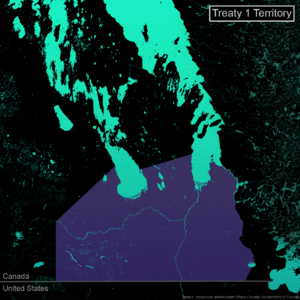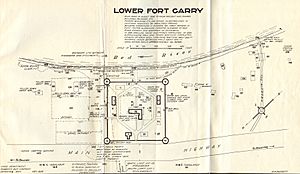Treaty 1 facts for kids
Treaty 1 is an important agreement made on August 3, 1871. It was signed between the British Crown and the Anishinabe and Swampy Cree nations. This treaty is also known as the "Stone Fort Treaty." It was the first in a series of agreements called the Numbered Treaties, which took place from 1871 to 1921. Many people saw this first agreement as a way to create peace and friendship.
However, after eight days of talks, the Indigenous groups agreed to give up all their lands in southern Manitoba to the Crown forever. In return, they would receive yearly payments and items like clothing and farm supplies. But within a year, the Indigenous communities told the Canadian government that some promised items, called the “Outside Promises,” had not been given to them. Yet, settlers continued to move onto the land.
On April 30, 1875, the Canadian government finally ordered that all “Outside Promises” must be kept. They were to be part of the main Treaty 1 agreement. Still, because Canadian officials and Indigenous communities had different ideas and understandings when the treaty was made, it remains a debated topic today.
Contents
History of Treaty 1
Treaty 1 is also known as the Stone Fort Treaty. It was the first treaty signed after Canada became a country in 1867. It was also signed one year after Manitoba became a province within Canada.
Why the Treaty Was Made
The treaty was created because both the Canadian government and local Indigenous communities wanted to secure land and resources. The Anishinabe and Swampy Cree Nations wanted to keep their traditional lands. They also sought security as they faced new ways of life with many settlers arriving.
The Canadian government wanted to expand westward. They aimed to bring Indigenous peoples into their new settlements. Through Treaty 1 and the other ten treaties, Canadian officials hoped to gain land peacefully. They had heard about many violent conflicts between American officials and Indigenous peoples in the United States. They wanted to avoid similar problems in Canada.
Adams George Archibald, the new leader of Manitoba, also wanted a treaty. He wanted to secure land around Lake Winnipeg and the Red River Valley. This land was needed for farming and to get natural resources. For leaders like Archibald, expanding into Western Canada was about developing farms and towns. It was less about trade, which had been the main economic activity there for a long time.
How Negotiations Happened
The talks for Treaty 1 lasted eight days. They began on July 27 and ended on August 3. Governor Archibald and his commissioner, Wemyss Mackenzie Simpson, led the Canadian government side. They invited Indigenous communities to meet at Lower Fort Garry, also known as Stone Fort. About one thousand Indigenous people attended, including adults and children. They were led by chiefs like Mis-koo-kenew, or Red Eagle, also known as Henry Prince.
In his first speech, Archibald spoke about Queen Victoria. He called her the "Great Mother" who wanted to treat Indigenous peoples fairly. He said she would support their needs and hoped they would start farming. The governor then explained the Canadian government's terms. He introduced the idea of reserves. He promised that Indigenous ways of life would continue. He said they would not be forced to farm. They could choose to live on reserves if they wished. He also said they could keep using their traditional lands for hunting, fishing, and other ways of life.
After hearing Archibald's speech, the Indigenous leaders returned days later. They brought their own list of demands for the treaty. This included asking for large areas of land for each person or family.
However, Archibald and the other Canadian officials thought this demand was too high. They negotiated the land rights down. They agreed to about "160 acres of land for a family of five." This was similar to the land rights given to British settlers under the Dominion Lands Act. After much discussion, both sides agreed. The treaty was signed on August 3.
What Treaty 1 Said
The final parts of Treaty 1 stated the following: The Indigenous peoples would give a large part of land in what is now southeast and south-central Manitoba to Governor Archibald and the Crown. This land included areas around Lake Manitoba, Lake Winnipeg, and the Red River Valley.
In return, the Canadian government would give each group a reserve. This reserve would be large enough to give each family of five 160 acres of land. The amount would change based on the family's size. Also, each member of these groups would get three dollars as a gift. They would also receive fifteen dollars yearly for a family of five. This yearly payment could be cash or items like clothing, blankets, or hunting supplies. The government also promised to provide and maintain a school on each reserve if one was wanted.
The Outside Promises
Within a year of Treaty 1 being signed, Governor Archibald heard news. The Swampy Cree and Anishinabe peoples said some treaty terms were not being fulfilled. These were known as the “Outside Promises.” They were many items promised to Indigenous peoples beyond the written treaty text. These items had not yet been given to them. Examples included special clothing for Chiefs and their advisors, farming supplies like plows, and animals like oxen and cows for farming.
A new commissioner was appointed to help the Indigenous peoples. The issue was even brought to court. But the Canadian government did not fix the “Outside Promises” until April 30, 1875. This was seven years later. At that time, the government ordered that the verbally promised items were part of Treaty 1. Therefore, the commissioner had to provide them. Also, the yearly payment of three dollars to each group member was raised to five dollars a year. Finally, the order stated that each Chief would get an extra twenty dollars annually. They would also receive more clothing items than first promised.
Why Treaty 1 Was Important
The signing of Treaty 1 was the start of many treaties over the next few decades. It showed that the Canadian government was very interested in the West. They saw it as more than just a place for trade. They saw it as a good place for farming and for more settlers to live. It was also a peaceful way to gain land. For Governor Adams Archibald, the treaty allowed him to develop businesses like mills and farms. These would be on the rich land around Lakes Winnipeg and Manitoba and in the Red River Valley.
For the Anishinabe and Swampy Cree Nations, Treaty 1 meant much more. They believed it was a way for them to survive and adapt. Huge changes were coming to their land and were already starting. Their leaders thought a treaty with the Crown would give them security. This was important as many settlers would soon move onto their lands. Also, Indigenous peoples believed the treaty would help with the serious decline of buffalo. The buffalo decline threatened their way of life. In the end, by signing the treaty, Indigenous leaders hoped to connect with the “Great White Queen Mother.” This connection would ensure safety and benefits for their people.
List of Treaty 1 First Nations



